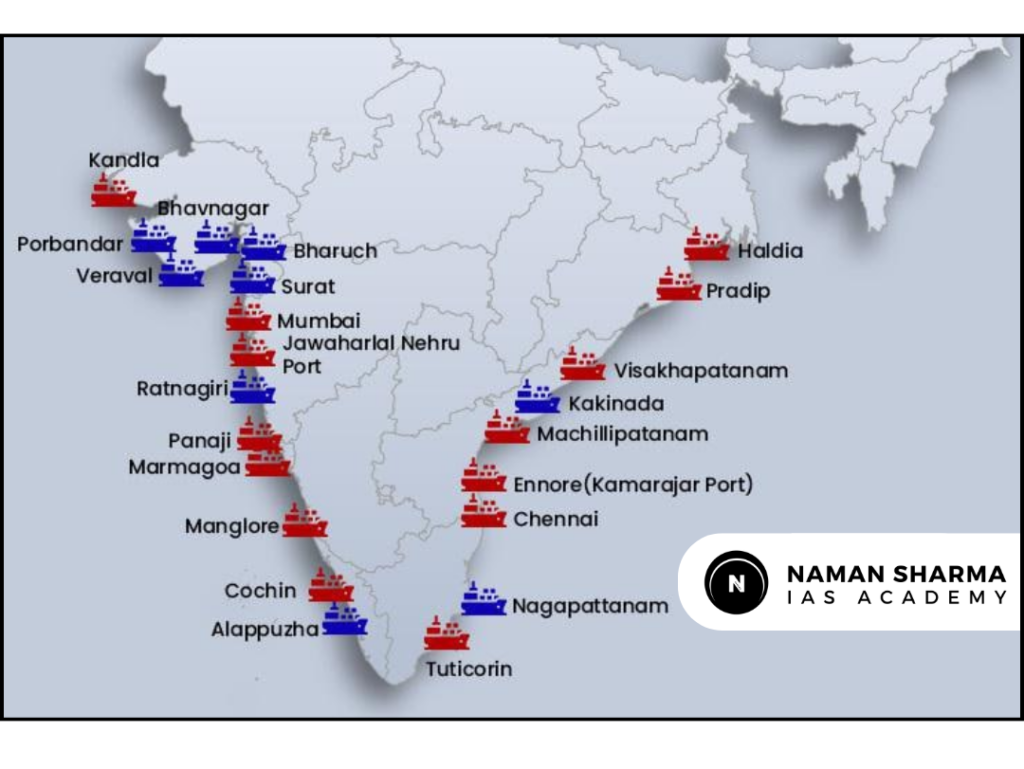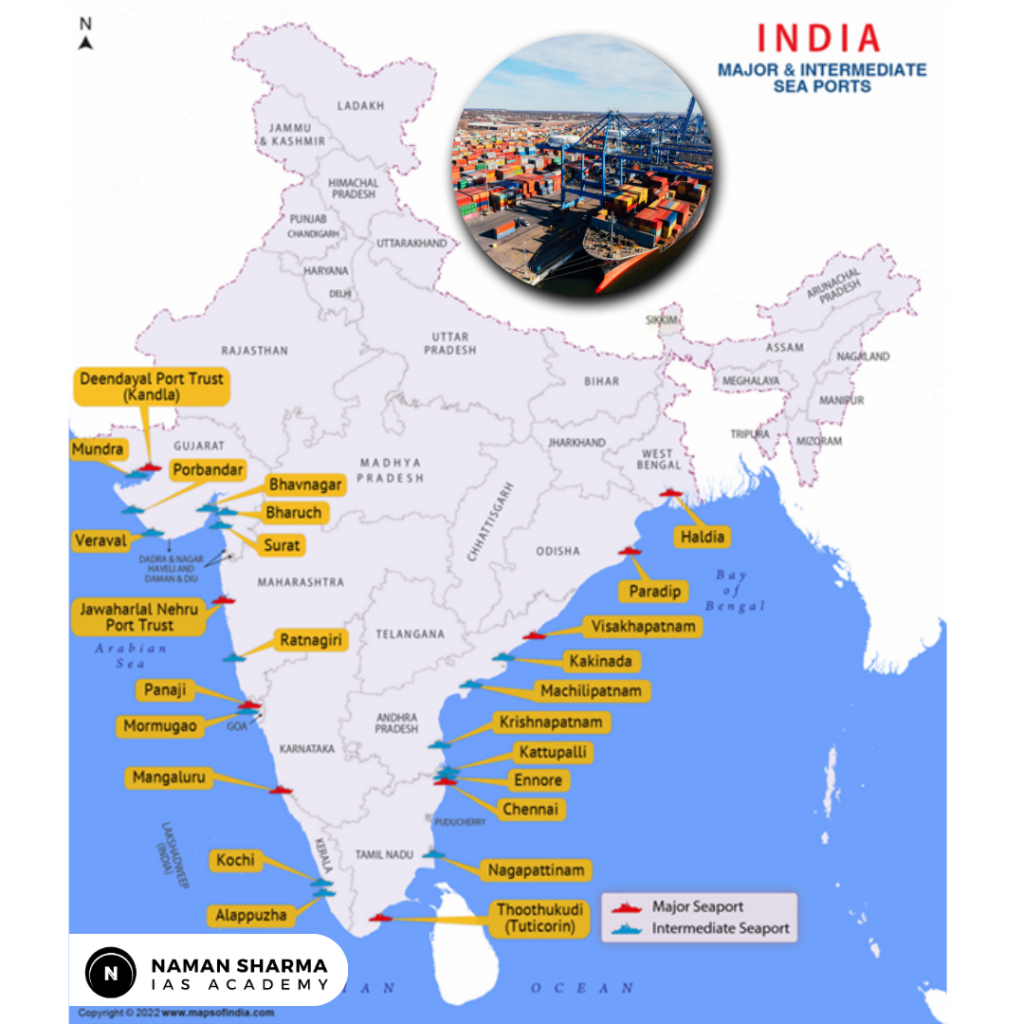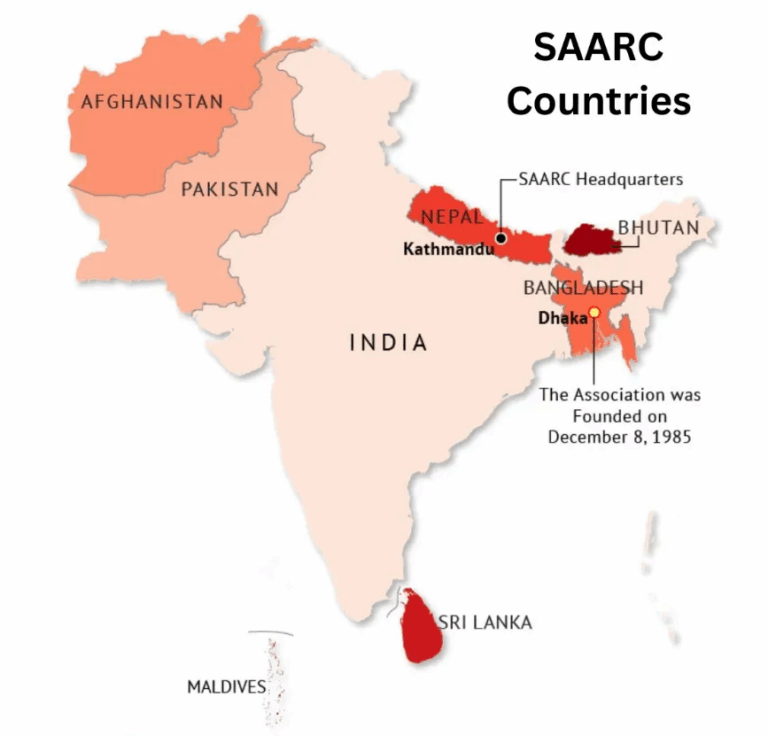PORT ECONOMY WILL DRIVE INDIA’s GROWTH
“From garlands of ports to garlands of growth”
Relevance – Mains: GS3 Infrastructure: Energy, Ports, Roads, Airports, Railways
Prelims : Geographical Locations ports and factual information
Context – launch of the ₹8,800 crore Vizhinjam International Deepwater Multipurpose Seaport in Kerala’s capital.
HISTORICAL SIGNIFICANCE

INSTITUTIONAL STRUCTURE : 13 MAJOR AND 200 MINOR PORTS
MAJOR PORTS
- Managed by the Central Government.
- Falls under the Union List.
- Major Ports Authorities Act 2021 (Repealed the earlier Major Ports Trust Act, 1963). The Government of India appoints a Board of Trustees to oversee each major port. Their responsibilities include port development,management and operations.
MINOR PORTS
- Managed by the State governments through the State Maritime Board (Gujarat, Maharashtra and Tamil Nadu).
- Falls under the Concurrent List. Comes under the jurisdiction of respective State Governments but the Union Government has overriding legislative and executive powers.
- All the Non-Major Ports (minor ports) are governed under the Indian Ports Act of 1908.
STATUS OF PORT INFRASTRUCTURE
- Over 95% of India’s trade by volume and 65% by value is done using maritime transport facilities at ports.
- India’s key ports had a capacity of 1,598 million tonnes per annum (MTPA) in FY22.
- Turnaround time( time that is taken between the arrival of a vessel and its departure) has reduced to 62.16 hours in FY21
- Non-major ports accounted for 45% of the total cargo traffic at Indian ports in FY22.
SIGNIFICANCE OF PORT INFRASTRUCTURE IN INDIA
- Economic Growth & Trade Facilitation:
● 95% of India’s trade by volume and 70% by value is maritime-based (Ministry of Ports, 2023). - Strategic Maritime Dominance:
● SAGAR Doctrine: Enhances India’s role as a net security provider in the Indian Ocean.
● Countering China: Development of Andaman & Nicobar Islands as a naval hub and Chabahar Port (Iran), operationalized in 2024,bypassing Pakistan to access Central Asia. - Employment & Regional Development:
● Sagarmala Programme: Aims to create 10 million jobs by 2035 through port-led industrialization.
● Example: Vizag Port’s expansion generated 50,000 jobs in Andhra Pradesh, boosting local MSMEs.
● Data: Coastal Economic Zones (CEZs) under Sagarmala could add $500 billion to GDP by 2035 (NITI Aayog). - Reducing Logistics Costs:
● Current Logistics Cost: ~14% of GDP (vs. global avg. of 8%). Port modernization aims to cut this to 10% by 2030. - Regional Connectivity & Global Partnerships:
Eastern Maritime Corridor: Chennai-Vladivostok route reduced transit time to Russia by 16 days(trial shipment in 2023).
Indo-Pacific Economic Framework (IPEF): India’s collaboration with Japan on the Chennai Bengaluru Industrial Corridor enhances supply chain resilience. - Environmental Sustainability:
● Green Port Initiatives: Cochin Port, India’s first fully solar-powered port, saves 3 lakh tonnes of CO₂ annually.
PRELIMS SPECIAL
- Artificial port – Tuticorin, Chennai, Mangalore, Visakhapatnam
- Largest container transshipment port and first transshipment– Kochi
- Largest container and largest artificial port and largest cargo- JNPT
- Second largest container port and largest port in Bay of Bengal– Chennai
- Largest natural deep water harbour port – Mumbai
- Only riverine port – Shyama Prasad Mukherjee port, Kolkata
- Largest port by volume of cargo- Kandla
- Landlocked harbour– Visakhapatnam
- India’s first deep water transshipment port – VIZHINJAM PORT (Kerala)

HIGHLIGHTS FROM NCERT
Types of port on the basis of specialised functions:
(i) Oil Ports: These ports deal in the processing and shipping of oil. Some of these are tanker ports and some are refinery ports. Maracaibo in Venezuela, Esskhira in Tunisia, Tripoli in Lebanon are tanker ports. Abadan on the Gulf of Persia is a refinery port.
(ii) Ports of Call: These are the ports which originally developed as calling points on main sea routes where ships used to anchor for refuelling, watering and taking food items. Aden, Honolulu and Singapore are good examples.
(iii) Packet Station: These are also known as ferry ports. ferry ports. These packet stations are exclusively concerned with the transportation of passengers and mail across water bodies covering short distances. These stations occur in pairs located in such a way that they face each other across the water body, e.g. Dover in England and Calais in France across the English Channel.
(iv) Entrepot Ports: These are collection centres where the goods are brought from different countries for export. Singapore is an entrepot for Asia. Rotterdam for Europe, and Copenhagen for the Baltic region.
(v) Naval Ports: These are ports which have only strategic importance.These ports serve warships and have repair workshops for them. Kochi and Karwar are examples of such ports in India.
Prelims Practice Questions
Question: Consider the following pairs:
| PORT | Well Known as |
| 1. Kamarajar Port | First major port in India registered as company |
| 2. Mundra Port | Largest privately owned port in India |
| 3. Visakhapatnam Port | Largest container port in India |
How many of the above pairs are correctly matched?
a) Only one pair
b) Only two pairs
c) All three pairs
d) None of the pairs
Q 1. Which one of the following was a very important seaport in the
Kakatiya kingdom? [2017]
(a) Kakinada
(b) Motupalli
(c) Machilipatnam (Masulipatnam)
(d) Nelluru
Answer: (b)
Q. With reference to ancient South India, Korkai, Poompuhar, and Muchiri
were well known as: [2023]
a) Capital cities
b) Ports
c) Centres of iron- and- steel making
d) Shrines of Jain Tirthankaras
Answer : (b)
MAINS PRACTICE QUESTION
Questions: “Port infrastructure is not merely an economic asset but a geopolitical lever for India in the Indo-Pacific region.”. Discuss the challenges in achieving world-class port infrastructure and suggest innovative solutions to address them. (15 marks, 250 words)







